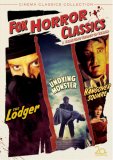As I’ve indicated in this space before, one of the joys of the DVD age is the chance to see, at long last, films that one might have heard about since childhood, but that were unavailable until now. A recent addition to Fox’s Cinema Classics line is a case in point. Fox Horror Classics consists of three movies directed by John Brahm, and the one I want to talk about today is The Undying Monster (1942), which I first read about over thirty years ago.
The occasion of my initial encounter with the movie was a mention of it in Denis Gifford’s A Pictorial History of Horror Movies (quite the seminal book in my childhood, as, I imagine, it was for many horror fans my age). This is what Gifford writes:
“Taken from Jessie Douglas Kerruish’s good 1936 novel, the tale of a family cursed since the Crusades was moody stuff, quite spoilt by the British censor’s scissors. Not only did he remove the carefully-photographed final metamorphosis, leaving audiences to wonder why the dim thing that the police shot should suddenly look like John Howard, but he also insisted on the title being changed to The Hammond Mystery. Fortunately, enough of Brahm’s brilliance was devoted to less shocking sequences so that most of the mood remained. Lucien Ballard swung his camera round an ancient room, alighting on odd objects at each dour bong of midnight. Casting and Cornish atmosphere were both good, too, perhaps because Brahm did his first work at Twickenham studios. Only one thing spoiled the script. The rune, obligatory to any werewolf film, ran: ‘When the stars are bright on a frosty night, / Beware the baying in the rocky lane.’ To film fans there was only one Rocky Lane: the Republic Western star!”
So now I’ve finally seen the film, and what an odd thing it is. First, I must correct Gifford on one point: the second line of the rune refers not to “the baying” but “thy bane.” At any rate, what Gifford says about the mood is absolutely true, especially in the opening scene. This is especially notable in 1942, as the dominant Universal horror films were losing most traces of subtlety. Brahm’s film is closer in spirit to the Val Lewton horrors of the time (Cat People, I Walked with a Zombie, and so on). The chilling, gothic mood of the setting, the feisty heroine and the chilling initial attack promise much. As enjoyable as the rest of the film is (moving along at a brisk 63 minutes), it does not quite live up to that promise, however. The main problem is the introduction of an American-accented detective from Scotland Yard, presented very much as a Sherlock Holmes figure, complete with comic-relief Doctor Watson sidekick (female in this case). Once they arrive on the scene, the film becomes a fairly standard Old Dark House mystery, regaining some of its force as the climax closes in. The flaws in the film are pretty interesting in and of themselves, however. It feels like two films working at odds with each other (the investigation and the gothic), and there is also the problem of not knowing the difference between ambiguity and an inability to make up one’s mind. The Lewton films were always consistent in tone all the way through, and played with supernatural ambiguity perfectly. Here, on the other hand, there is an absolutely marvellous moment where the supernatural nature of the problem is confirmed in the lab (a sample of wolf hair dematerializes while under spectrograph analysis). But the conclusion has a rather jocular scene where lycanthropy is discussed as if it were a perfectly natural psychological condition. Um….
With that said, this is still a nice little horror picture, perfect for a blustery winter’s night, and its arrival on DVD is something of an event. It isn’t Brahm’s most successful picture. That honour might well fall to The Lodger, also included in the box set. But let’s leave that for next time.


